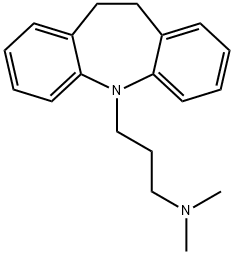
イミプラミン
化学名:イミプラミン
英語化学名:IMIPRAMINE
CAS番号:50-49-7
分子式:C19H24N2
分子量:280.41
EINECS:200-042-1
MOL File50-49-7.mol
| 融点 | 174°C |
| 沸点 | bp0.1 160° |
| 比重(密度) | 0.9935 (rough estimate) |
| 屈折率 | 1.5640 (estimate) |
| 酸解離定数(Pka) | pKa 9.66(H2O,t = 25,I=0.025) (Uncertain) |
| 水溶解度 | 18.23mg/L(24℃) |
| Solvent | Ethanol under nitrogen |
| Concentration | 1 mCi/ml |
| Specific Activity | 60-90 Ci/mmol |
| BCS Class | 1 |
| EPAの化学物質情報 | Imipramine (50-49-7) |
| 有毒物質データの | 50-49-7(Hazardous Substances Data) |
| 毒性 | A tertiary amine tricyclic antidepressant that is thought to exert its therapeutic effect by inhibiting the reuptake of serotonin and norepinephrine centrally. A major metabolite is N-desmethylimipramine (desipramine), also used as an antidepressant drug. Desipramine differs from imipramine in being a better blocker of norepinephrine, rather than serotonin, uptake. Side effects, including sedation and drowsiness, dry mouth, urinary retention, constipation, and orthostatic hypotension, are probably due to the anticholinergic, anti-α-adrenergic, and antihistaminergic receptor-blocking properties. Imipramine should not be used in conjunction with a monoamine oxidase inhibitor or other treatment that increases catecholamine concentrations (e.g., drugs containing sympathomimetic amines). Imipramine should be avoided in patients with cardiovascular disease or seizure disorder, or in those who may abuse alcohol, as imipramine lowers seizure threshold, can produce cardiovascular toxicity and may potentiate the effects of alcohol. Imipramine intoxication can include CNS abnormalities (e.g., drowsiness, stupor, coma, and extrapyramidal symptoms), cardiac arrhythmia, and respiratory depression. Children appear to be particularly vulnerable to the cardiotoxic and seizure-inducing effects of high doses of imipramine. The oral LD50 in female rats is 305 mg/kg. |